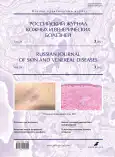A new principle for the diagnosis morphea in the onset of the disease
- Authors: Zaslavsky D.V.1, Sidikov A.A.2, Garyutkina L.V.1, Pyagai G.B.2, Alaeva M.D.2, Ibragimova N.S.2, Malikova N.N.2, Kozlova D.V.1
-
Affiliations:
- St. Petersburg State Pediatric Medical University
- Tashkent State Stomatology Institute
- Issue: Vol 24, No 3 (2021)
- Pages: 263-274
- Section: DERMATOLOGY
- URL: https://journals.rcsi.science/1560-9588/article/view/72328
- DOI: https://doi.org/10.17816/dv72328
- ID: 72328
Cite item
Abstract
BACKGROUND: Because of the low specificity morphea clinical manifestations in early stages, the differential diagnosis is difficult.
AIMS: The purpose of the research is to propose a new diagnostic method for early stages of localized scleroderma.
MATERIALS AND METHODS: During 2011–2020, 77 patients with clinical manifestations of morphea and 127 controls were examined and included in the study at the LenOblCenter. All participants were conducted a transcutaneous oximetry with the “TCM-400” Radiometer apparatus. The tissue oxygen perfusion (tcpO2) level from 40 to 50 mm Hg was considered as a reversible decrease, from 30 to 40 mm hg was a borderline decline and the value below 30 mm hg was critical. The following diagnostic skin biopsy was conducted in all 77 patients
RESULTS: Skin biopsy allowed to form 4 research groups: 40 patients with morphea, 12 patients with granuloma annulare, 15 patients with small plaque parapsoriasis and 10 individuals with large plaque parapsoriasis. 7 (17.5%) patients with morphea had normal tcpO2 values, 9 (22.5%) patients had significant decrease of tcpO2, 24 patients (60%) showed a reversible decrease of tcpO2. 3/12 (25%) patients with granuloma annulare and 1 patient (10%) with large plaque parapsoriasis had minor oxygen level decrease. Measurement on the healthy skin showed tcpO2 decrease in patients with comorbidities ― 3/77 (3.9%) in research group and 28/127 (22%) in controls.
CONCLUSIONS: Transcutaneous oximetry is a new perspective direction in the diagnostic algorithm of the morphea based on the pathogenesis and morphological features of the disease.
Keywords
Full Text
##article.viewOnOriginalSite##About the authors
Denis V. Zaslavsky
St. Petersburg State Pediatric Medical University
Author for correspondence.
Email: venerology@gmail.com
ORCID iD: 0000-0001-5936-6232
SPIN-code: 5832-9510
MD, Dr. Sci. (Med.), Professor
Russian Federation, 2 Litovskay street, 194100, Saint-PeterburgAkmal A. Sidikov
Tashkent State Stomatology Institute
Email: medik-85@bk.ru
ORCID iD: 0000-0002-0909-7588
MD, Dr. Sci. (Med.)
Uzbekistan, TashkentLyubov V. Garyutkina
St. Petersburg State Pediatric Medical University
Email: liubovgariutkina.md@gmail.com
SPIN-code: 3863-8682
Graduate Student
Russian Federation, 2 Litovskay street, 194100, Saint-PeterburgGrigoriy B. Pyagai
Tashkent State Stomatology Institute
Email: gregbae@mail.ru
ORCID iD: 0000-0002-6456-6594
SPIN-code: 2941-7297
MD, Cand. Sci. (Med.), Associate Professor
Uzbekistan, TashkentMuyassar D. Alaeva
Tashkent State Stomatology Institute
Email: allaeva_m.d@mail.ru
ORCID iD: 0000-0002-5765-5425
MD, Cand. Sci. (Med.), Associate Professor
Uzbekistan, TashkentNargiza S. Ibragimova
Tashkent State Stomatology Institute
Email: nargiza.is23@gmail.com
ORCID iD: 0000-0002-9715-9901
MD, Cand. Sci. (Med.), Associate Professor
Uzbekistan, TashkentNilufar N. Malikova
Tashkent State Stomatology Institute
Email: dr.malikova@gmail.com
ORCID iD: 0000-0001-6964-8372
MD, Cand. Sci. (Med.), Associate Professor
Uzbekistan, TashkentDarya V. Kozlova
St. Petersburg State Pediatric Medical University
Email: dashauchenaya@yandex.ru
ORCID iD: 0000-0002-6942-2880
SPIN-code: 3783-8565
Student
Russian Federation, 2 Litovskay street, 194100, Saint-PeterburgReferences
- Rodionov AN, Nasyrov RA, Zaslavsky DV, et al. Diffuse connective tissue diseases: clinic and morphology of skin lesions. Saint Petersburg : Navoi; 2015. 160 p. (In Russ).
- Rodionov AN, Zaslavsky DV, Chuprov IN, et al. Dermatopatho-logy of inflammatory skin diseases. Tashkent; 2014. 208 p. (In Russ).
- Zhao B, Guan H, Liu JQ, et al. Hypoxia drives the transition of human dermal fibroblasts to a myofibroblast-like phenotype via the TGF-β1/Smad3 pathway. Int J Mol Med. 2017;39(1):153–159. doi: 10.3892/ijmm.2016.2816
- Zaslavsky DV, Sydikov AA, Garyutkina LV, et al. New aspects of the pathogenesis of limited scleroderma: a practical justification. Russian Journal of Skin and Venereal Diseases. 2020;23(4):227–237. (In Russ). doi: 10.17816/dv48907
- Mayes MD. Classification and epidemiology of scleroderma. Semin Cutan Med Surg. 1998;17:22–26. doi: 10.1016/s1085-5629(98)80058-8
- Arisi M, Cavazzana I, Cerutti ME, et al. Antibodies against antigens related to scleroderma in a cohort of patients with morphea. Ital Dermatol Venereol. 2018;153:451–458. doi: 10.23736/S0392-0488.16.05464-X
- Khatri S, Torok KS, Mirizio E, et al. Autoantibodies in morphea: an update. Front Immunol. 2019;10:1487. doi: 10.3389/fimmu.2019.01487
- Asano Y, Fujimoto M, Ishikawa O, et al. Diagnostic criteria, severity classification and guidelines of localized scleroderma. J Dermatol. 2018;45(7):755–780. doi: 10.1111/1346-8138.14161
Supplementary files
















